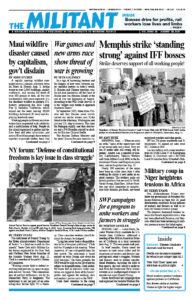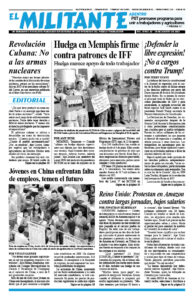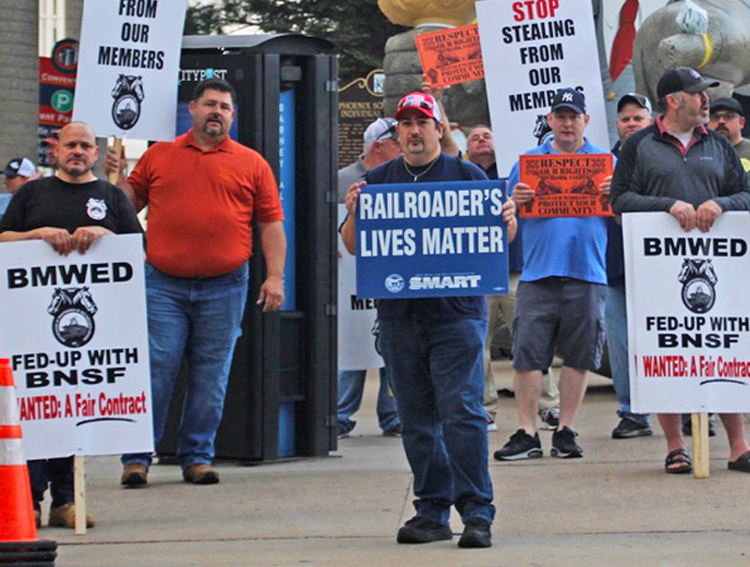Since the Feb. 3 Norfolk Southern derailment and fires contaminated East Palestine, Ohio, working people everywhere have been paying attention to the job conditions and life disruptions the bosses’ drive for profits inflicts on rail workers and their families. During picketing by rail workers’ unions last fall — part of their fight for a contract with livable wages, schedules, crew sizes and safety protections — many carried signs saying, “Railroaders lives matter.”
But the rail bosses organize their operations in ways that all too often lead to the death and maiming of workers. Four rail workers have been killed over the last seven weeks.
Twenty-eight-year-old Derek Scott Little, a CSX conductor trainee, was killed on the job June 26 at the Seagirt Marine Terminal in Baltimore. Jacory Ceaser, 24, was killed July 15 when he was crushed between two intermodal cars in Chicago. Forty-year-old Travis Bradley, a CSX conductor from Ridgeley, West Virginia, was killed Aug. 6 when he was riding on the side of a train through a close clearance in Cumberland, Maryland.
And a contract worker, whose name has not yet been released, was killed after being struck by railroad track equipment Aug. 4 at a remote location between Great Barrington and Sheffield, Massachusetts.
The Class 1 rail bosses’ operating system is based on longer and heavier trains — up to 3 miles long — with smaller and smaller crews, on schedules that dictate constant fatigue, with insufficient training and immeasurable other ways of cutting corners on safety. Some 30% of the total workforce on these railroads have been eliminated in less than a decade. They’ve boosted profits by over 50%, and are hungry for more.
Don Grissom, an assistant to the president of the Brotherhood of Railway Carmen — which inspects, maintains and repairs rail cars — told a 2022 congressional hearing how this works. A Union Pacific railroad yard that had 74 carmen in 2018 now has 24 on duty to inspect trains, he said.
Each rail car has up to 180 inspection points counting both sides of the car, he testified. “One defective car can derail an entire train.” Carmen “were permitted around 3 minutes per car on predeparture inspections.” At the same UP yard, “on a 150 car train, we’re only allowed 2.5 hours maximum to perform inspections,” a minute or less per car.
“However, when the FRA [Federal Railroad Administration] is on the property, that rule changes to 4 hours and they give us four Carmen to do it. But as soon as the FRA leaves, it’s back to business as usual.”
“Why do this?” he asked. “Simple: profits.”
To mark the six-month anniversary since the East Palestine derailment, the AFL-CIO’s 37-union Transportation Trades Department issued a public statement. “There have been more than 60 high-profile derailments since East Palestine,” it said. “Through it all, freight rail companies have maintained their fundamental disregard for public safety. Safety is just a buzzword to the railroads.”
East Palestine: ‘We stand with you’
“To the people of East Palestine: we have not forgotten you. We see you. We stand with you. We fight with you. Solidarity forever,” says the statement.
On Aug. 11 the Occupational Safety and Health Administration announced it had levied four citations against Norfolk Southern for violations of workers’ safety following the derailment. Most had to do with the bosses’ drive to get the tracks relaid on top of the contaminated soil and ballast one day after the derailment.
OSHA cited the company for failing to make sure workers wore chemical resistant footwear when working on contaminated ground, for letting workers with no respiratory protection pour cement on contaminated soil and not training them about hazardous chemicals.
The bosses agreed to pay a fine of $49,111, part of a settlement with the agency and the Brotherhood of Maintenance of Way Employees rail union.
Following the derailment and the public outcry raised by rail workers and area residents alike, the nation’s largest freight railroads reluctantly agreed to participate in a federal safety program that allows workers to report safety issues anonymously. But no rail lines have actually signed up.
Vincent G. Verna, a vice president of the Brotherhood of Locomotive Engineers and Trainmen, said the rail companies “do not want to relinquish their ability to discipline their employees who report something.”
“Working conditions on the railroads today make for an unforgiving life,” Lance Anton, a conductor and SMART-TD union member with some 12 years experience, told the Militant. “Rail workers have to deal with working 12 hours shifts or longer, at times in difficult weather, and dealing with continuous harassment and speedup.”
He said rail bosses need to be forced to provide more training before new hires are set up. “It takes two to three years experience for conductors and engineers to work safely and with confidence, to learn the company rules, the yard and road terrains, to spot cars at industry sidings, where other crews are working and many derailments happen.”
No rail worker needs to die on the job! We need to use union power to fight for workers control over operating conditions and safety as the only way to reverse the treacherous conditions rail workers and those that live and work near railroad property face.
Our unions need to fight for trains no longer than 50 cars, and a minimum of four-person crews, with two on the head engine and two on a caboose or rear engine. And they need to take control over new-hire training.
Joe Swanson is a retired conductor and member of SMART-TD.


